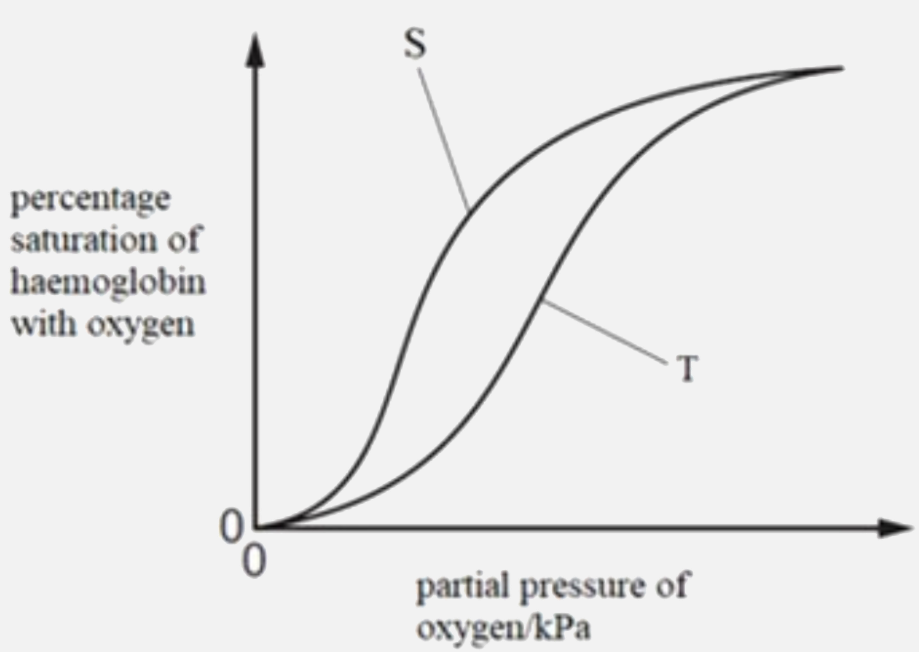Define oxygen dissociation curve. Can you suggest any reason for its sigmoidal pattern?
Step-by-Step Solution:
1. Definition of Oxygen Dissociation Curve:
The oxygen dissociation curve is a graphical representation that illustrates the relationship between the saturation of hemoglobin with oxygen (HbO2) and the partial pressure of oxygen (pO2) in the blood. On the y-axis, we plot the percentage of hemoglobin saturation, while on the x-axis, we plot the partial pressure of oxygen.
2. Understanding the Sigmoidal Pattern:
The oxygen dissociation curve exhibits a sigmoidal (S-shaped) pattern due to the cooperative binding nature of hemoglobin. This means that as one molecule of oxygen binds to hemoglobin, it increases the affinity of hemoglobin for additional oxygen molecules.
3. Initial Phase:
At low partial pressures of oxygen, hemoglobin has a low affinity for oxygen, and the saturation increases slowly. This initial phase of the curve is relatively flat because it takes time for the first oxygen molecule to bind.
4. Steep Phase:
As the partial pressure of oxygen increases, more oxygen molecules bind to hemoglobin, leading to a rapid increase in saturation. This steep phase of the curve indicates that hemoglobin's affinity for oxygen is increasing as more oxygen molecules are bound.
5. Plateau Phase:
Eventually, as the hemoglobin becomes nearly saturated with oxygen, the curve levels off. This plateau indicates that most of the hemoglobin binding sites are occupied, and additional increases in oxygen partial pressure result in minimal increases in saturation.
6. Conclusion:
The sigmoidal shape of the oxygen dissociation curve reflects the cooperative binding of oxygen to hemoglobin, where the binding of one oxygen molecule enhances the binding of subsequent molecules until saturation is reached.
The oxygen dissociation curve is a graphical representation that illustrates the relationship between the saturation of hemoglobin with oxygen (HbO2) and the partial pressure of oxygen (pO2) in the blood. On the y-axis, we plot the percentage of hemoglobin saturation, while on the x-axis, we plot the partial pressure of oxygen.
The oxygen dissociation curve exhibits a sigmoidal (S-shaped) pattern due to the cooperative binding nature of hemoglobin. This means that as one molecule of oxygen binds to hemoglobin, it increases the affinity of hemoglobin for additional oxygen molecules.
At low partial pressures of oxygen, hemoglobin has a low affinity for oxygen, and the saturation increases slowly. This initial phase of the curve is relatively flat because it takes time for the first oxygen molecule to bind.
As the partial pressure of oxygen increases, more oxygen molecules bind to hemoglobin, leading to a rapid increase in saturation. This steep phase of the curve indicates that hemoglobin's affinity for oxygen is increasing as more oxygen molecules are bound.
Eventually, as the hemoglobin becomes nearly saturated with oxygen, the curve levels off. This plateau indicates that most of the hemoglobin binding sites are occupied, and additional increases in oxygen partial pressure result in minimal increases in saturation.
The sigmoidal shape of the oxygen dissociation curve reflects the cooperative binding of oxygen to hemoglobin, where the binding of one oxygen molecule enhances the binding of subsequent molecules until saturation is reached.
Topper's Solved these Questions
Similar Questions
Knowledge Check
The oxygen dissociation curve is
AparabolaBslopeCsigmoidDstright line.The oxygen dissociation curve will show a right shift in case of:
Ahigh PCO2Bhigh PO2Clow PCO2Dless H+ concentration
Balmer series was observed and analysed before the other series .Can you suggest a reason for such an order?
View SolutionAthletes do warming up exercise of short distance and then gradually increasing the distance. Can you assign any reason for this activity by them?
View SolutionIn which conditon oxygen dissociation curve of haemoglobin shift to right of normal curve ?
View SolutionThe graph shows the oxygen dissociation curves of haemoglobin from two species of mammals, s and T .

Which statements could explain the difference in the oxygen dissociation curves of species S and species T ?
I. Species T has higher haemoglobin concentration in its red blood cells than species S.
II. The haemoglobin in species T has a lower affinity for oxygen than the haemoglobin in species S.
III. Species T may be living at a higher altitudes than species S.
View SolutionHow many factors shift the oxygen dissociation curve to the right shift?
I Low partial pressure of oxygen
ii High concentation of carbon dioxide
iii High number of hydrogrn ions
iv Low body temperature
v Daily exercise
vi Haemoglobin of babies or fetal haemoglobin
View SolutionOxygen haemoglobin dissociation curve will shift to right on decrease of
View Solution
